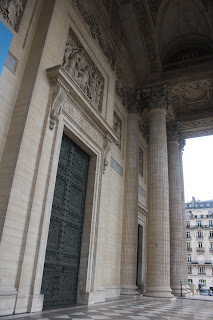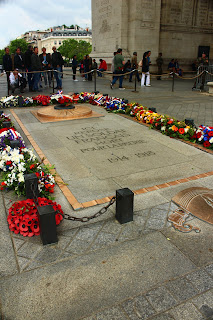Paris, with it's long, long history (founded in the 3rd century BC!!), has a lot of interesting things to find, from the massive to the tiny. Justin already mentioned the Last Standard Metre (the only one surviving in Paris). This one is a remnant of the July Revolution in 1830 (not the famous French Revolution you've heard about) - a canonball still lodged in the wall of a hotel, with the date engraved below it. Neat!
We headed along the left bank of the Seine to the Eglise Saint-Gervais, which is the oldest church in Paris (dates back to the 500's, but most recently rebuilt in the 1100s) - it was very pretty! I like this style a lot more than Notre-Dame (S-G is Romanesque, while Notre Dame is gothic). I found it very light and airy, and the stained glass windows had a abstract style I've not seen before in a church. It almost reminded me of Group of Seven paintings. This church is not a big tourist draw, but is very centrally located, so if you're in the city I would pop in for a quick (free) look!
The church was almost empty except for a few people praying, so I didn't feel too comfortable taking a lot of photos there and disturbing them. Here are two beautiful photos that I found at a blog here:

 |
| Photo credit: http://leftbankgirl.blogspot.co.uk/2016/03/in-heart-of-left-bank-eglise-of-saint.html |
 |
| Photo credit: http://leftbankgirl.blogspot.co.uk/2016/03/in-heart-of-left-bank-eglise-of-saint.html |
Justin got approximately 2-3 cups of sauerkraut, with 4 types of sausages, 2 types of bacon, and boiled potatos. I ordered the charcuterie, and honest to god, other than a basket with slices of bread, this is what arrived:
So good thing we were walking 15,000 to 20,000 steps daily, am I right?
Another thing we saw briefly was the reading room at the Bibliothèque Sainte-Geneviève. We were shown around by a volunteer as you are supposed to have a student card to enter, and he was lovely enough to give us a brief history of the building (I'm sorry I forget his name!). It used to be an abbey and was renovated into a library of the University of Paris, and the reading room is one of the two famous and architecturally significant rooms of their type in the city. The books here are so old that you can't get them from the shelf yourself - you must use one of two computers to direct library staff to bring you the book you want, and in some cases you can't even touch them yourself. The space was amazing - I wish the libraries at Western or OVC had been like this!
The architect, Henri Labrouste, also designed the other famous reading room at the National Library (unfortunately closed for renovations). Here is a picture I found elsewhere (and was sad again that it was closed!!). If you like stories about architecture, I found this website very interesting!
 |
| Photo credit: https://www.pinterest.com/pin/427630927092184671/ |
Across the road, the Pantheon used to be part of the Abbey of Saint-Geneviève, and is now a masoleum. We didn't go in (we saw our fill of dead people at the Catacombs!) but appreciated the architecture nonetheless.
All of this walking (and meat!) made us very thirsty. Good thing there are hundreds of beautiful public drinking water fountains all over Paris! After one of their many civil wars, Paris' aquaducts had been destroyed, and it was difficult for citizens to afford safe drinking water (even then, the Seine was incredibly polluted). Many poor people had to rely on alcohol rather than water, as this was less expensive and safer to drink. Sir Richard Wallace (an Englishman) helped to fund rebuilding efforts, and commissioned many fountains. These were made by Charles-Auguste Lebourg, and each fountain has four figures representing kindness, simplicity, charity, and sobriety.We were in Paris during Euro 2016, but luckily the games were not played anywhere that really affected us. Although we heard about violent clashes between hooligans, and were a little worried about terrorist threats to the venues themselves, it really didn't have any effect on our trip whatsoever. There were a lot of fans from many different nations that we saw out and about, having a great time!
Although we walked a lot in Paris (we've been averaging 15,000-20,000 steps per day of sightseeing since Justin started keeping track), we took advantage of their excellent metro system. Unlike Rome (I'll post the map for laughs when we get to those posts!), Paris has an excellent and wide-reaching system. The rubber tires were the world's first (and inspired those of the Montreal subway system). We found that buying two carnets of 10 tickets was the best option for us.
 |
| Photo credit: http://about-france.com/paris-metro-map.htm |
The Paris Métro or Métropolitain (French: Métro de Paris) is a rapid transit system in the Paris Metropolitan Area. A symbol of the city, it is noted for its density within the city limits and its uniform architecture, influenced by Art Nouveau. It is mostly underground and 214 kilometres (133 mi) long. It has 303 stations, of which 62 have transfers between lines. There are 16 lines, numbered 1 to 14 with two lines, 3bis and 7bis, which are named because they started out as branches of lines 3 and 7; later they officially became separate lines; the Metro is still numbered as if these lines were absent. Lines are identified on maps by number and colour, and direction of travel is indicated by the terminus.Me again! Each station had its own decorations and style (both inside and out), and because of the many lines crisscrossing the city there were often 2-3 long sets of stairs or escalators to descend to the line you wanted. It made for interesting travel!
It is the second busiest subway system in Europe, after Moscow. It carried 1.541 billion passengers in 2012, (up from 1.524 billion in 2011), 4.210 million passengers a day. It is one of the densest metro systems in the world, with 245 stations within the 86.9 km2 (34 sq mi) of the city of Paris.
 |
| Justin enjoying a baguette on the metro on his birthday |
 |
| This was neat! There is a temporary exhibit on one side of the pyramid that makes it 'vanish' into the facade behind |
 |
| Another entry to the courtyard |
This is the Medici column, the only surviving piece of the hotel that Catherine de'Medici (widow of Henry II) had built - some legends say she built this tower to give her astrologer a private entrance to her bedroom. You can't climb it any more, which is a shame. Although the hotel is gone, the Bourse was built around the column.
We then had some time to kill, so wandered through the streets, and ducked into one of the old covered passageways for shopping.
As we were celebrating Justin's birthday in Paris, we had to have an authentic French meal! This restaurant writes your orders and even tallies your bill on the tablecloth. We had some escargots, but sadly there were no frogs legs on the menu!
After dinner we headed to one of the northern arrondisements (neighbourhoods) to look around. We found a wall with 'I Love You' written in all the languages of the UN:
... as well as the Passe-Muraille, a statue which is based on the French story of a man who can walk through walls, and uses this power to rob banks and get away with crime, until he one day loses this ability and is stuck in a wall forever.
We headed up to the high ground of Montmarte to see Sacre-Coeur, a church with a wonderful view on the top of a hill. There was a cute little sightseeing train, but we only saw it once at the peak. Darn!
The inside of the church was pretty, but it was the outside and the view that were spectacular.
Then one of my favourite things of the whole trip happened. When leaving the church, we saw a bunch of people sitting on the steps in front taking in the sunset and thought we'd join in. Our timing was perfect, as there was a open-air free concert put on by a french guitarist (mostly singing in English), getting people in the crowd from all over the world to help sing along.
We enjoyed this concert so much we ended up buying one of the guitarist's cd's, and will enjoy the music and memories for years to come.
After arriving back at our lodgings (merci beaucoup, Vincent!), we got up the next morning hoping to tick off a last few must-see sites! We knew we had to cover a lot of ground, and we thought we'd do the Parisian thing and bike. They have rental bikes (similar to Bixi) which, after you spend a few euros for a day pass, are free for the first 30 minutes! We zig-zagged our way through Paris, only once missing that 30 minute deadline.
The Arc de Triomph is a massive war memorial, at the centre of the craziest roundabout I've every seen. In fact, I just googled 'craziest roundabout video' and the #1 hit was from the top of the Arc de Triomph.
Enjoy the madness!
I've really come to enjoy using roundabouts in Europe. They are a hell of a lot faster than 4-way stops, and they keep the traffic flowing, but there is a certain amount of having to take your turn or be stuck forever. Most roundabouts give right-of-way to those already in the roundabout. You have to wait to enter until your way is clear. This roundabout is the exact opposite - right of way is given to those entering! I have no idea how this came to be, or why we didn't see a single accident while we were there. I'm really glad I wasn't driving near there! There are 10 lanes, 12 exits, and remarkably little honking. Apparently insurance companies automatically split liability for collisions here 50/50 for each driver, and some insurance policies don't cover it at all.
 |
| Looking along the Champs-Élysées |
 |
| Thanks for the excellent framing, person who took our picture! In the other one he got our feet but cut off half of the Arc. |
 |
| Here you can see the many major roads converging. Photo credit Gérard Janot, from https://en.wikipedia.org/wiki/Arc_de_Triomphe |
This made me laugh!
We set off on our bicycles down the Champs-Élysées, then I realized that I wanted to live - and the heavy cobblestones, crazy traffic and likelihood of being doored were at direct odds with that goal. So we detoured south to the Seine and found a lovely bike path along the river. We stopped here and there for photos and to swap out our bikes when the time got low.
This is not the Pont des Arts (the bridge most famous for the 'love locks', which have recently been removed, but Passerelle Solférino. Since Paris started to get rid of the locks (read more, and see some pretty impressive photos here ), the custom has spread to other bridges over the Seine. I'm sure they'll all be converted to glass-sided structures eventually to stop this from happening (as portions of the Pont des Arts actually collapsed under the extra weight and fell into the river).
 |
| I really loved the lock in the top centre! |
 |
| More delicious-looking goodies (from another bakery, but oh well) |
 |
| Even Angelina's bathrooms were posh! |





























































